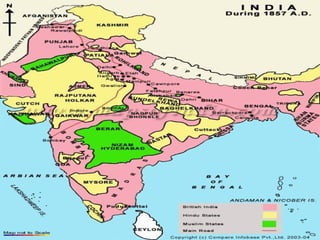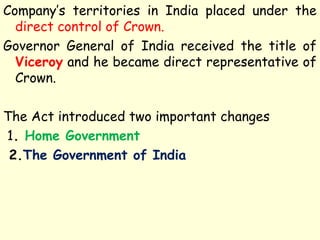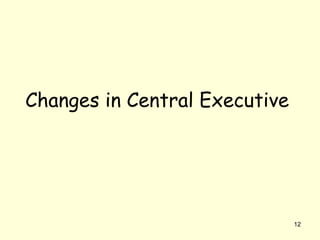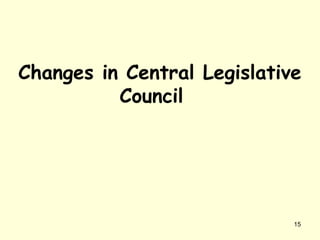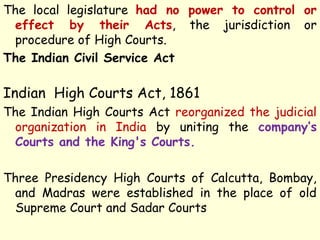1858 act
- 1. 1
- 2. 2
- 3. Dalhousie policy of frequent wars and annexation created discontentment among the army as well as the native rules of India. The presidency governments were also not happy about centralization of legislative powers in the Governor General-in-Council. Transfer of Power It is significant to note that the process of transfer of power from the Company to the Crown had already began even since the enactment of first Charter Act. • 1600-1772 • 1773, 1784, 1793, 1813, 1833 and 1853 3
- 4. Government of India Act 1858 4
- 5. Company’s territories in India placed under the direct control of Crown. Governor General of India received the title of Viceroy and he became direct representative of Crown. The Act introduced two important changes 1. Home Government 2.The Government of India
- 6. Changes in Home Government The Act abolished the both, the Board of Control and Court of Directors. A Special Secretary of State appointed for Indian affairs and all powers transferred to him. A fifteen members Council created in England to assist Secretary of State for Indian affairs. Eight out of fifteen members of this Council of India were appointed by the Crown and rest of seven were to be elected by the Court of Directors. 6
- 7. • Council was to meet at lest once in a week and its quorum was five. • The secretary of State was required to place a financial statement of expenditure and revenues before the Parliament every year. • He was also to report on the moral and material progress of the Country. 7
- 8. Changes in the Government of India. The Governor General of India and Governors of the presidencies were to be appointed by the Crown and members of the Councils by the Secretary of Sate for Indian affairs. The military and naval forces of the Company were transferred to the Crown. All treaties made by the Company were to be binding on the Crown. 8
- 9. 1861 Indian Councils Act
- 10. Dissatisfaction of Presidencies regarding their legal power and they were demanding more participation from presidencies. The demand of the Indian public for some substantial changes in the Governmental machinery of India. Disputes between Madras Government and Supreme Court. 10
- 11. Changes in Central Executive Changes in Central Legislative Changes relating to Provinces 11
- 12. Changes in Central Executive 12
- 13. The Act enlarged the Executive Council of the Governor General and the Act provided that it shall consist of five members, 3+2 Three ordinary members, one law member and one finance member. Commander-in-Chief was appointed as an Extraordinary member of E.C. He was also empowered to appoint a president to preside over the meeting of the Council in his absence.
- 14. The Governor General had power to overrule the majority in the Council in matters of safety and interests of British possessions in India. Governor General got complete authority to divide or alter the limits of any presidency or territory. Government of India became a Cabinet Government presided over by a Governor General. First time portfolio system introduced in India 14
- 15. Changes in Central Legislative Council 15
- 16. For the purposes of making law the Act empowered the Governor General to enlarge his Council by adding not less than 6 and not more than 12 members. Not less than one half of the members were to be non-officials. There were 45 Indians nominated as additional non-official members from 1862 to 1892. New Legislative Council was authorized to make laws for all people, Indians, British and foreigners and for all the courts of justice and the public servants within the territories of British India.
- 17. The assent of the Governor General was required for every Act passed by the Council, and any such Act would be disallowed by Her Majesty, acting through the Secretary. The Governor General was also empowered to issue ordinances. independently which were to remain in force for six months unless disallowed by the crown.
- 18. Changes relating to Provinces 18
- 19. The Act restored the Legislative powers of the Provincial Legislature of Bombay and Madras. For the purpose of making Laws the Executive Council of Governor enlarged by an addition of 4 to 8 members for a term of two years. The Provincial councils, not empowered to take into consideration any of the law relating to army, foreign and political affairs, customs, coinage and currency, Penal Code, religion and on communication system without prior sanction of the governor General.
- 20. The local legislature had no power to control or effect by their Acts, the jurisdiction or procedure of High Courts. The Indian Civil Service Act Indian High Courts Act, 1861 The Indian High Courts Act reorganized the judicial organization in India by uniting the company’s Courts and the King's Courts. Three Presidency High Courts of Calcutta, Bombay, and Madras were established in the place of old Supreme Court and Sadar Courts

